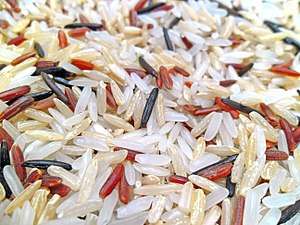White rice
White rice is milled rice that has had its husk, bran, and germ removed. This alters the flavor, texture and appearance of the rice and helps prevent spoilage and extend its storage life. After milling, the rice is polished, resulting in a seed with a bright, white, shiny appearance.
The milling and polishing processes both remove nutrients. A diet based on unenriched white rice leaves many people vulnerable to the neurological disease beriberi, due to a deficiency of thiamine (vitamin B1).[1] White rice is often enriched with some of the nutrients stripped from it during its processing.[2] Enrichment of white rice with B1, B3, and iron is required by law in the United States.[3][4] As with all natural foods, the precise nutritional composition of rice varies slightly depending on the variety, soil conditions, environmental conditions and types of fertilizers.
Adopted over brown rice in the second half of the 19th century because it was favored by traders, white rice has led to a beriberi epidemic in Asia.[5][6]
At various times, starting in the 19th century, brown rice and wild rice have been advocated as more healthful alternatives.[7][8] The bran in brown rice contains significant dietary fiber and the germ contains many vitamins and minerals.[9]
Typically, 100 grams of uncooked rice produces around 240 to 260 grams of cooked grains, the difference in weight being due to absorbed cooking water.
See also
References
- ↑ Carpenter KJ (2000). Beriberi, white rice, and vitamin B : a disease, a cause, and a cure. Berkeley, CA: University of California Press. ISBN 978-0-520-22053-9.
- ↑ "Christiaan Eijkman, Beriberi and Vitamin B1". nobelprize.org. Retrieved 28 September 2015.
- ↑ Perkins S. "How Is White Rice Healthy for Our Body?". LIVESTRONG.COM. Retrieved 28 September 2015.
- ↑ "7 U.S. Code § 1431c - Enrichment and packaging of cornmeal, grits, rice, and white flour available for distribution". cornell.edu. Retrieved 28 September 2015.
- ↑ Arnold D (July 2010). "British India and the "beriberi problem", 1798-1942". Medical History. 54 (3): 295–314. PMC 2889456. PMID 20592882.
- ↑ Cavanagh J, Broad R (2011-03-09). "Why Billions Eat Unhealthy Rice and Shouldn't". Institute for Policy Studies. Retrieved 2018-06-01.
- ↑ Hendrick B. "Brown Rice vs. White Rice: Which Is Better?". WebMD. Retrieved 28 September 2015.
- ↑ "White or brown rice? Mee pok or spaghetti? Take our food quiz and digest the facts about glycaemic index". The Straits Times. Retrieved 2016-06-15.
- ↑ "Difference between white and brown rice". reComparison.
External links
| Wikimedia Commons has media related to Rice as food. |
